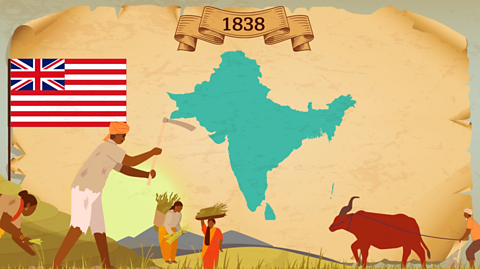Key points
- Following the abolition of slavery across the British Empire, Indian indentured labourers provided a cheap source of labour to the government.
- Many Indians travelled from India to the Caribbean, South Africa, Mauritius and Fiji to work on sugar plantations between 1838 and 1917. The impact of this can still be seen worldwide, with large communities of people of Indian descent in these countries.
- Most labourers went willingly, possibly because they were not fully aware of the conditions they would face. Others were forcibly taken to other colonies.
From abolition to indentured labour
The British government abolished slavery across the British Empire in 1833, although all enslaved people were required to continue to work under an apprenticeship schemeAfter the transatlantic slave trade was abolished, slave owners argued that they needed enslaved people to continue to work for them for at least four more years for very low wages so that they would not lose as much money. The conditions faced by apprentices were not very different to the conditions faced by enslaved people. from 1834 - 38. However, many refused to continue to work on British plantationsEstates and farms where enslaved people were forced to produce crops such as sugar, coffee or tobacco. after 1838. This meant that the British government were looking for another cheap source of labour to continue harvesting cotton, sugar, cocoa and tea.
One of the new sources of cheap labour came from British-controlled India. Between 1834 and 1917, Britain took more than 1 million Indian indentured labourerA person who is required to work for a specific period of time, generally for no or very little money. Following the abolition of slavery, the British Empire used indentured labour to send people to work across many colonised countries. to 19 British colonyA country, state or territory ruled over by another country, state or territory.. The people who signed contracts typically agreed to five years as an indentured labourer ā although many could not read or write and signed with a thumbprint. This meant that they could not read the conditions they agreed to.
Many people ended up working much longer than five years and had to remain in the colony they had been taken to because they could not afford the journey back home. Some people were kidnapped and forced to travel abroad and work as labourers.
What were living conditions like for Indian indentured labourers?

Living conditions were very poor. Despite the Abolition Act, there were few differences between slavery and indentured labour. One difference was that indentured labourers did receive some pay, however, it was often less than promised. Also, indentured labour was for a contracted period, typically five years - not a lifetime.
17 per cent of Indians died aboard ships on the journey from India to the Caribbean, and more died working on the plantations. The death rate of indentured labourers working in Jamaica in 1870 is thought to have been as high as 12 per cent.
Indentured labourers outside of the Caribbean

While most of the indentured labourers were initially taken to the Caribbean, a significant number also went to other colonies in the British Empire, such as Mauritius, Uganda and South Africa. In these colonies they worked on plantations, in mines and on new railway systems the British wanted to introduce.
32,000 Indian labourers went to Uganda as indentured labourers. In the 1890s, they started to work on the railway that would stretch from Mombasa, Kenya to Lake Victoria in Uganda. The British wanted to build this railway to improve transport in their east African colonies. Being able to travel by railway made it easier for the British to visit different parts of the colony and enforce their rules.
Nearly 2,500 labourers died in the process of building the railway, and 6,500 labourers were injured. Most Indians returned home after its completion. However, several thousand remained and grew in number to become the Ugandan Asian community.
There were also several thousand other Indians who migrated to Uganda to work for British settlers on farms and plantations, which produced:
- Sugar
- Rubber
- Cocoa
- Coffee

What was it like to work on the Uganda Railway?

Working on the Uganda Railway was difficult and dangerous.
Many indentured labourers became ill. A number of workers were killed by lions during the construction of the railway, with some historians estimating that up to 135 were attacked and killed.
Almost 2,500 workers died during the construction of the railway.
Why did Indians agree to become indentured labourers?
famineAn extreme shortage of food. and poverty were a common part of life for many Indians under British rule. Indians had to pay high taxesAn amount of money that must be paid to the government by individual citizens and companies. This pays for public services, such as education and healthcare. to the British, and the jobs available to most Indians did not pay enough to cover these taxes and also pay for basic food and shelter.
The Bengal famine of 1770 killed an estimated 10 million people as a result of a huge crop shortage. Several other severe famines hit India throughout the 1800s.
As a result, the opportunity to work as an indentured labourer was appealing because:
- People were told it would only be for a set period of years, typically five.
- They were told they would receive relatively good wages.
- Some believed they would only be relocating to other parts of India.
- It was an opportunity to escape famine and poverty.
- Most were told that the cost of their return journey would be covered, although sometimes this promise was not kept.

The impact across the world today
In 1917 the system of indentured labourers officially ended when the British government abolished it ā but the impact of this system can still be seen today. Although many indentured labourers returned to their homes in India, large numbers also settled in the places they had been taken to. Some found new jobs and some had the opportunity to buy the land they had been working on.
As a result, there are still large communities of people of Indian descentA term used to describe people who were not born in India, but whose ancestors were born in India. in:
- The Caribbean
- South Africa
- Uganda
- Kenya
- Malaysia
- Mauritius
These communities still often follow traditional Indian cultural practices. This can be seen in their names, religious celebrations, food and languages.
However, many of these communities have also adopted the traditional cultures of their new homeland. For example, around 65 per cent of people in Mauritius are of Indian descent. Most people speak Mauritian CreoleA language that uses grammar and vocabulary from French, English and Hindi., but it is also common for Indo-MauritiansA term used to describe people of Indian descent who live in Mauritius and identify as Mauritian. to speak Hindi, Gujarati and other languages native to India.
Test your knowledge
Play the History Detectives game! gamePlay the History Detectives game!
Analyse and evaluate evidence to uncover some of historyās burning questions in this game.

More on The British Empire
Find out more by working through a topic
- count4 of 4

- count1 of 4

- count2 of 4
